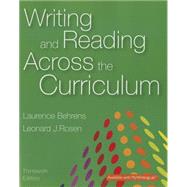013410675X / 9780134106755 Writing and Reading Across the Curriculum Plus MyWritingLab with Pearson eText - Access Card Package
Package consists of:MyWritingLab is not a self-paced technology and should only be purchased when required by an instructor.
- 0133944131 / 9780133944136 MyWritingLab with Pearson eText - Access Card
- 013394414X / 9780133944143 MyWritingLab with Pearson eText - Inside Star Sticker
- 0133999017 / 9780133999013 Writing and Reading Across the Curriculum
For courses in Writing across the Curriculum or Writing in the Disciplines.
Effective writing skills for students of all majors and interests
One of the best-selling interdisciplinary composition texts for over twenty-five years, Writing and Reading Across the Curriculum guides students through the essential college-level writing skills of summary, critique, synthesis, and analysis.
The book is divided into three parts. Part one, “Structures and Strategies,” takes students step-by-step through the process of writing papers based on source material, explaining and demonstrating how summaries, critiques, syntheses, and analyses can be generated from the kinds of readings students will encounter later in the book–and throughout their academic careers. Part two, “Brief Takes,” bridges the gap between writing instruction and readings with a series of step-by-step exercises. The anthology in part three provides a wide range of carefully selected, cross-disciplinary readings, including two new chapters on rumor and advertising. Topics are both engaging and teachable, and students will appreciate how these topics correspond to their courses in the humanities, sciences, and social sciences.
Also available with MyWritingLab™
This title is also available with MyWritingLab–an online homework, tutorial, and assessment program designed to engage students and improve results. Within its structured environment, students practice what they learn, test their understanding, and pursue a personalized study plan that helps them better absorb course material and understand difficult concepts.








